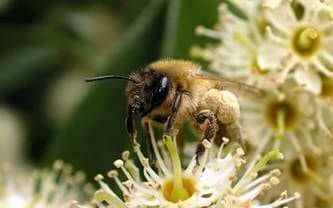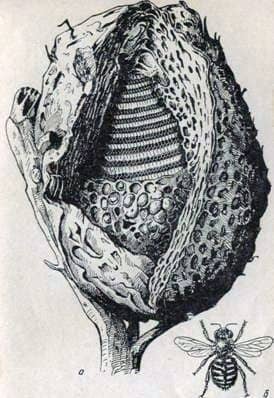Bezalaceous bees of melipon

Bees that do not sting? Yes, there are such! They exist even a few hundred species, but not with us. They live in the tropics of the Old and New Worlds. There were attempts to acclimatize these bees from us. Who does not want to have a “rose without thorns!” But this was a double mistake. First, they are not suitable for our climate, and, secondly, although the toxic stink is atrophied, they are very tightly plugged. When, while protecting their home, bees massively attack the enemy, they try to penetrate into the most sensitive places of the skin – armpits, corners of the eyes, etc. At the same time, they so strongly bite into the enemy’s body that they can not be shaken completely: they will rather allow tear off his head than let go. Knowing all this, many will prefer to deal with the stings of our bees.
Possessing many peculiarities peculiar only to them, unrelieved bees (melipones) are separated into an independent subfamily, isolated from the bee family (apin). Melipons are in many respects more primitive than honey bees. They do not observe such a perfect distribution of work and such careful care of the brood. If honey bees spend the whole season with unremitting attention care for their larvae and feed them, then the melipons, as well as single bees, supply the stored eggs with a stock of dough from honey and pollen, seal the cell and no longer care about the growing offspring. For the construction of honeycombs, they use the wax emitted by them, mixed with earth, clay or wood.
Many types of melipon already have the art of making hexahedral cells. As to the organization of public life, they greatly surpassed the bumblebee. Many of the melipon live in numerous families, which reproduce in swarms, like the families of our honey bees. Their working individuals are not just underdeveloped females, like bumblebees; they differ also by a slightly different device


Fig. 114. a – a primitive nest of a beeless bee. Left – cells for brood; on the right – pots for stocks; b – a bee with a double increase.
So, among them there are bees with a body length that barely reaches two millimeters, real dwarfs of this kind, whose honeycombs with their round, randomly attached cells for brood and large honey pots are very similar to bumblebees. On the other hand, there are species that build up accurate, even wax honeycombs, which, unlike vertically hanging honeycombs of our honey bee, are located horizontally and only from the upper side have cells with brood. As pots of honey here, as well as in bumblebees, serve as pot-bellied receptacles. In some species, they reach the size of a chicken egg.

Fig. 115. A-nest of a wild bee, melipones. The nest shell is partially removed to show a horizontally located honeycomb with open cells (top) and honey pots (bottom) (greatly reduced); b – a bee with a double increase.
Differences are found not only in the way of building honeycombs, but also in the entire organization of community life. Therefore, among the numerous species of these social insects, we should look for simpler steps in the development of abilities for expedient interaction and perception of information. How did the honey bees reach such a highly differentiated language? Can the “comparative study of the language” of their relatives serve as a starting point for an answer to this question? The study of bumblebees in this respect can not give us anything new. At them we in vain tried to find out ability to transfer and perception of the information.
Only in small, unrelieved bees, whose structures look like bumblebeans, we really touch the sources of the bee-tongue. Finding a good source of feed, they mobilize their girlfriends, telling them the purpose of the search flight, but they do this the simplest of all possible ways: after returning home, the lucky picker agitatedly runs around the honeycomb, pushes the idly sitting friends on him, drawing their attention, and when three or four bees turn to her, she, shaking all over, quickly runs toward the gate. There she turns again to show the output of a new small group of bees following her. Bees, mobilized by the floral scent that they feel on the body of the picker, get to know the smell of the source of the bribe. They fly out of the hive and, having no idea of the direction to the goal of the flight and the distance to it, without any plan, they search for it until they perceive by the organs of smell a promising smell. It is clear that only a few of them achieve success.
More highly organized representatives of melipon have better abilities in this respect. If they find a rich source of food in a place remote from their home, then an hour later everything is already teeming with assiduous pickers, as is the case with honey bees. But the hope of tracing and justifying this way in the development of the “language” of our bees would have been in vain, because the bezly bees are not the ancestors of our honeybee, but the lateral line, and although both of them probably originate from a common root, they developed completely different techniques perception and transmission of information.
Melipons are not as noble as honey bees. They do not see an elegant dance that gives an idea of the whereabouts of the goal of the forthcoming flight. Mobilizing their girlfriends, the pickers only run excitedly on the honeycombs and abruptly buzz, the hundredth shakes, and thanks to this, the bees sitting on it find out that there are bribes in nature, but they do not yet know exactly where. As if in anticipation, they are going to swarm in front of their home. And then something amazing happens. The bee, who has discovered the source of the bribe and who has already flown to him many times over this time, comes to extreme excitement. Then, as if making an important decision, she falls to the ground near the source of the bribe and treats her mouth with a grass stalk, a stone or some other notable object, leaving on it a selection of powerfully developed maxillary glands,
Thus, on the way to the nest, every two or three meters making stops on stems, leaves, stones and other objects, it leaves its fragrant trail everywhere, which makes it easier for beginners to get from the nest of the family to the source of the bribe. Once this is done, it invades a swarm of waiting bees and, with its excited flights back and forth, guides it to the correct path to the source of the bribe. Consequently, here “assistants” are included in the collection not alone and not independently, like honey bees, but in groups and accompanied by a scout.
We have just seen a new example of how ingenious nature is in achieving its goal. But we still have not managed to restore the development of the “language of bees”.
Bezalaceous bees of melipon
